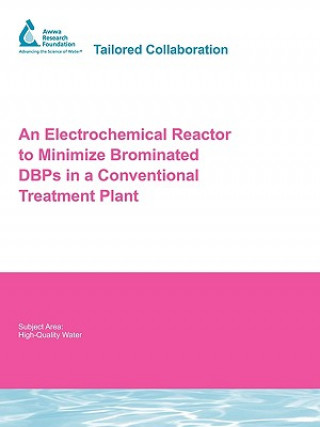
Code: 08845237
Electrochemical Reactor to Minimize Brominated DBPs in a Conventional Treatment Plant
by L. Boulos, Helene Baribeau, B. Carrico, G. Crozes, D. Kimbrough, I. H. (Mel) Suffet
The presence of bromide in drinking water typically leads to the formation of brominated DBPs upon chlorination. Bromide is not removed by conventional water treatment processes. Ion-exchange and high-pressure membrane filtration ... more
- Language:
 English
English - Binding: Paperback
- Number of pages: 152
Publisher: IWA Publishing, 2008
- More about this

You might also like
-

Dune
34.84 zł -33 % -

Haunting Adeline
125.81 zł -1 % -

Berserk Deluxe Volume 2
212.65 zł -1 % -

White Nights
15.40 zł -23 % -

Powerless
47.24 zł -14 % -

Atomic Habits
59.22 zł -26 % -

Dune Messiah
46.33 zł -3 % -

Berserk Deluxe Volume 3
215.07 zł -1 % -

One Day
32.63 zł -36 % -

Berserk Deluxe Volume 1
211.84 zł -2 % -

Iron Flame
62.95 zł -26 % -

Surrounded by Idiots
37.77 zł -26 % -

Harry Potter and the Prisoner of Azkaban (Minalima Edition)
170.44 zł -2 % -

Gravity Falls Journal 3
89.45 zł -

Heaven Official's Blessing: Tian Guan Ci Fu (Novel) Vol. 1
89.04 zł -1 % -

The Creative Act
100.22 zł -15 % -

Dune
47.34 zł -23 % -

Hunting Adeline
126.52 zł -4 % -

A Little Life
47.24 zł -14 % -

Children of Dune
46.73 zł -2 % -

Heaven Official's Blessing: Tian Guan Ci Fu (Novel) Vol. 2
86.73 zł -3 %
Availability alert
Enter your e-mail address and once book will be available,
we will send you a message. It's that simple.
More about Electrochemical Reactor to Minimize Brominated DBPs in a Conventional Treatment Plant
 Book synopsis
Book synopsis
The presence of bromide in drinking water typically leads to the formation of brominated DBPs upon chlorination. Bromide is not removed by conventional water treatment processes. Ion-exchange and high-pressure membrane filtration remove bromide but produce a concentrated brine waste stream. One emerging technology for bromide removal is electrolysis. Limited design data on bromide removal by electrolysis are available in the literature. However, design parameters, operational constraints, and costs need to be defined. The objectives of the study were to (1) determine operational conditions under which electrolysis removes bromide and decreases the formation of halogenated disinfection by-products (DBPs); (2) investigate the effect of electrolysis on ozonation DBPs (bromate), bacterial regrowth, and taste andor; (3) evaluate the impact of electrolysis on conventional coagulation/flocculation/sedimentation and ozonation; (4) evaluate scalability and conceptual design issues; (5) determine preliminary capital and operational costs; and (6) determine future needs for demonstrating the technology. A four phased-approach was undertaken to conduct this project. During the first phase, the electrolytic reactor was designed, constructed, and activated. During the second phase, the electrolytic reactor was operated under several conditions of hydraulic residence time, current level, and influent bromide level. Key analytical parameters were measured, including bromide, bromine, chlorine, and THM and HAA concentrations. During the third phase, conventional treatment consisting of coagulation/flocculation/sedimentation and/or ozonation was tested downstream of electrolysis to investigate whether electrolysis is feasible in a conventional treatment plant context. During the fourth phase, scale up, safety, and conceptual design issues were identified and preliminary costs estimated. A workshop was held towards the end of the study to identify future needs.
 Book details
Book details
Book category Books in English Technology, engineering, agriculture Environmental science, engineering & technology Sanitary & municipal engineering
- Full title: Electrochemical Reactor to Minimize Brominated DBPs in a Conventional Treatment Plant
- Author: L. Boulos, Helene Baribeau, B. Carrico, G. Crozes, D. Kimbrough, I. H. (Mel) Suffet
- Language:
 English
English - Binding: Paperback
- Number of pages: 152
- EAN: 9781843392095
- ISBN: 9781843392095
- ID: 08845237
- Publisher: IWA Publishing
- Weight: 358 g
- Dimensions: 234 × 156 × 18 mm
- Date of publishing: 01. October 2008
safisfied customers
Since 2008, we have served long line of book lovers, but each of them was always on the first place.
Copyright! ©2008-24 libristo.pl All rights reservedPrivacyPoučení o cookies



 21 million books
21 million books Delivery 12.99 zł
Delivery 12.99 zł (32) 444 93 66 (8-15.30h)
(32) 444 93 66 (8-15.30h)